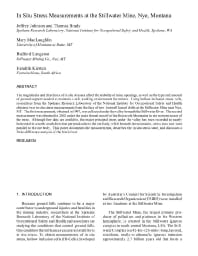Mining Publication: In Situ Stress Measurements at the Stillwater Mine, Nye, Montana
Original creation date: June 2003
Authors: JC Johnson, TM Brady, MM MacLaughlin, RB Langston, H Kirsten
NIOSHTIC2 Number: 20024084
Soil and Rock America 2003. 12th Panamerican Conf on Soil Mechanics and Geotechnical Engineering and the 39th U.S. Rock Mechanics Symposium, Vol. 1. Cambridge, MA: Massachusetts Institute of Technology, 2003 Jun; 1:337-344
The magnitudes and directions of in situ stresses affect the stability of mine openings, as well as the type and amount of ground support needed to maintain a safe working environment for miners. Using hollow inclusion stress cells, researchers from the Spokane Research Laboratory of the National Institute for Occupational Safety and Health obtained two in situ stress measurements from the face of two footwall lateral drifts at the Stillwater Mine near Nye, MT. The first measurement, obtained in 1997, was collected under the valley beneath the Stillwater River. The second measurement was obtained in 2002 under the main frontal massif of the Beartooth Mountains in the western sector of the mine. Although few data are available, the major principal stress under the valley has been recorded as nearly horizontal in a north-south direction perpendicular to the ore body, while beneath the mountains, stress runs east-west parallel to the ore body. This paper documents the measurements, describes the in situ stress state, and discusses a finite-difference analysis of the biaxial test.

NIOSHTIC2 Number: 20024084
Soil and Rock America 2003. 12th Panamerican Conf on Soil Mechanics and Geotechnical Engineering and the 39th U.S. Rock Mechanics Symposium, Vol. 1. Cambridge, MA: Massachusetts Institute of Technology, 2003 Jun; 1:337-344
- Advance and Relieve Mining: A Method to Mitigate the Effects of High Horizontal Stress on the Mine Roof
- Development of a Statistical-Analytical Approach for Assessing Coal Bump Potential
- Effect of the Dip and Excavation Orientation on Roof Stability in Moderately Dipping Stone Mine Workings
- Field Observations and Numerical Studies of Horizontal Stress Effects on Roof Stability in U.S. Limestone Mines
- A Gas Pressure-Based Drift Round Blast Design Methodology
- Horizontal Stress and Longwall Headgate Ground Control
- In Situ Estimation of Roof Rock Strength using Sonic Logging
- In-depth Survey Report: Control Technology for Environmental Enclosures - The Effect of Wind Speed Upon Aerosol Penetration Into an Enclosure at Clean Air Filter, Defiance, IA
- Safer Mine Layouts for Underground Stone Mines Subjected to Excessive Levels of Horizontal Stress
- Variation of Horizontal Stresses and Strains in Mines in Bedded Deposits in the Eastern and Midwestern United States